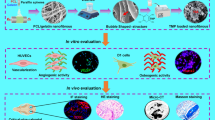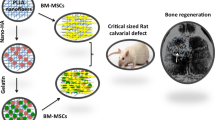Abstract
An appropriate cell source, effective cell modification, and proper supportive matrices are the main bases of tissue engineering. The effectiveness of anti-mir221 or hydroxyapatite (HA) in improving the osteogenic differentiation of mesenchymal stem cells (MSCs) has been reported previously. Herein, simultaneous application of these osteogenic inducers was investigated in vivo. The Poly-caprolactone (PCL)/HA nanofibers were characterized using contact angle measurement, tensile test, Fourier transform infrared spectroscopy, and electron microscopy. Rat MSCs were isolated, characterized and transfected with anti-mir221. The rats were divided into 4 groups and an 8 mm defect were created in the mid-calvaria of each rat by trephine bur. Group 1 received (PCL)/HA nanofibers, group 2 received (PCL)/HA nanofibers plus autologous MSCs, group 3 received (PCL)/HA nanofibers plus MSCs transfected with anti-mir221, and group 4 rats were left empty as an additional control group. Histomorphometric and radiomorphometric evaluation after 4 and 8 weeks revealed more new bone formation in the cell-treated groups compared to the scaffold alone group. There was evidence for a combination of increased osteoclasts and osteoblast vascular lake containing red blood cells in the anti-mir221 transfected group. New bone penetration into the scaffolds empirically demonstrated the capability of this combination for efficient osteointegration. Altogether, the co-application of HA and anti-mir221 transfected cells can enhance bone healing of the rat skull.









Similar content being viewed by others
References
Barrilleaux B, Phinney DG, Prockop DJ, O’Connor KC. Review: ex vivo engineering of living tissues with adult stem cells. Tissue Eng. 2006;12(11):3007–19.
Gupta D, Venugopal J, Mitra S, Giri Dev VR, Ramakrishna S. Nanostructured biocomposite substrates by electrospinning and electrospraying for the mineralization of osteoblasts. Biomaterials. 2009;30(11):2085–94.
Murugan R, Ramakrishna S. Design strategies of tissue engineering scaffolds with controlled fiber orientation. Tissue Eng. 2007;13(8):1845–66.
Wang M. Developing bioactive composite materials for tissue replacement. Biomaterials. 2003;24(13):2133–51.
Yoshimoto H, Shin YM, Terai H, Vacanti JP. A biodegradable nanofiber scaffold by electrospinning and its potential for bone tissue engineering. Biomaterials. 2003;24(12):2077–82.
Shin M, Yoshimoto H, Vacanti JP. In vivo bone tissue engineering using mesenchymal stem cells on a novel electrospun nanofibrous scaffold. Tissue Eng. 2004;10(1–2):33–41.
Bakhshandeh B, Hafizi M, Ghaemi N, Soleimani M. Down-regulation of miRNA-221 triggers osteogenic differentiation in human stem cells. Biotechnol Lett. 2012;34(8):1579–87.
Zhang X, Li Y, Chen YE, Chen J, Ma PX. Cell-free 3D scaffold with two-stage delivery of miRNA-26a to regenerate critical-sized bone defects. Nature communications. 2016;7:10376.
Bakhshandeh B, Soleimani M, Hafizi M, Ghaemi N. A comparative study on nonviral genetic modifications in cord blood and bone marrow mesenchymal stem cells. Cytotechnology. 2012;64(5):523–40.
Bakhshandeh B, Soleimani M, Ghaemi N, Shabani I. Effective combination of aligned nanocomposite nanofibers and human unrestricted somatic stem cells for bone tissue engineering. Acta Pharmacol Sin. 2011;32(5):626–36.
Khojasteh A, Eslaminejad MB, Nazarian H. Mesenchymal stem cells enhance bone regeneration in rat calvarial critical size defects more than platelete-rich plasma. Oral Surg Oral Med Oral Pathol Oral Radiol Endod. 2008;106(3):356–62 discussion 63.
Jafarian M, Eslaminejad MB, Khojasteh A, Mashhadi Abbas F, Dehghan MM, Hassanizadeh R, et al. Marrow-derived mesenchymal stem cells-directed bone regeneration in the dog mandible: a comparison between biphasic calcium phosphate and natural bone mineral. Oral Surg Oral Med Oral Pathol Oral Radiol Endod. 2008;105(5):e14–24.
Behnia H, Khojasteh A, Kiani MT, Khoshzaban A, Mashhadi Abbas F, Bashtar M, et al. Bone regeneration with a combination of nanocrystalline hydroxyapatite silica gel, platelet-rich growth factor, and mesenchymal stem cells: a histologic study in rabbit calvaria. Oral Surg Oral Med Oral Pathol Oral Radiol. 2013;115(2):e7–15.
Kurpinski KT, Stephenson JT, Janairo RR, Lee H, Li S. The effect of fiber alignment and heparin coating on cell infiltration into nanofibrous PLLA scaffolds. Biomaterials. 2010;31(13):3536–42.
Yang J, Bei J, Wang S. Enhanced cell affinity of poly (D, L-lactide) by combining plasma treatment with collagen anchorage. Biomaterials. 2002;23(12):2607–14.
Padalhin AR, ThuyBaLinh N, KiMin Y, Lee BT. Evaluation of the cytocompatibility hemocompatibility in vivo bone tissue regenerating capability of different PCL blends. J Biomater Sci Polym Ed. 2014;25(5):487–503.
Parfitt AM, Drezner MK, Glorieux FH, Kanis JA, Malluche H, Meunier PJ, et al. Bone histomorphometry: standardization of nomenclature, symbols, and units. report of the ASBMR Histomorphometry Nomenclature Committee. J Bone Miner Res. 1987;2(6):595–610.
Pogoda P, Priemel M, Rueger JM, Amling M. Bone remodeling: new aspects of a key process that controls skeletal maintenance and repair. Osteoporos int. 2005;16(Suppl 2):S18–24.
Robling AG, Castillo AB, Turner CH. Biomechanical and molecular regulation of bone remodeling. Annu Rev Biomed Eng. 2006;8:455–98.
Acknowledgments
Iran national science foundation financially supported this work.
Author information
Authors and Affiliations
Corresponding author
Ethics declarations
Conflict of interest
The authors have no conflicts of interest.
Electronic supplementary material
Below is the link to the electronic supplementary material.
10856_2016_5746_MOESM2_ESM.tif
Supplementary material 2 (TIFF 624 kb) Supplementary Fig. 1: SEM micrographs of electrospun scaffolds: (A) random fabrication, (B) aligned fabrication, (C) pure PCL, and (D) PCL fibers with nHA incorporation
10856_2016_5746_MOESM3_ESM.tif
Supplementary material 3 (TIFF 1501 kb) Supplementary Fig. 2: Creation of critical-size defect and scaffold implantation in rat calvaria
Rights and permissions
About this article
Cite this article
Sadeghi, M., Bakhshandeh, B., Dehghan, M.M. et al. Functional synergy of anti-mir221 and nanohydroxyapatite scaffold in bone tissue engineering of rat skull. J Mater Sci: Mater Med 27, 132 (2016). https://doi.org/10.1007/s10856-016-5746-x
Received:
Accepted:
Published:
DOI: https://doi.org/10.1007/s10856-016-5746-x




